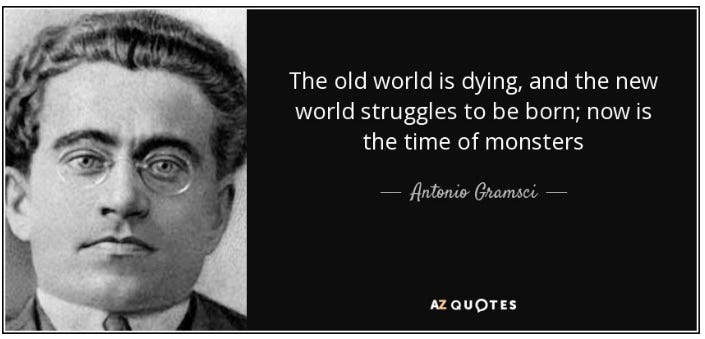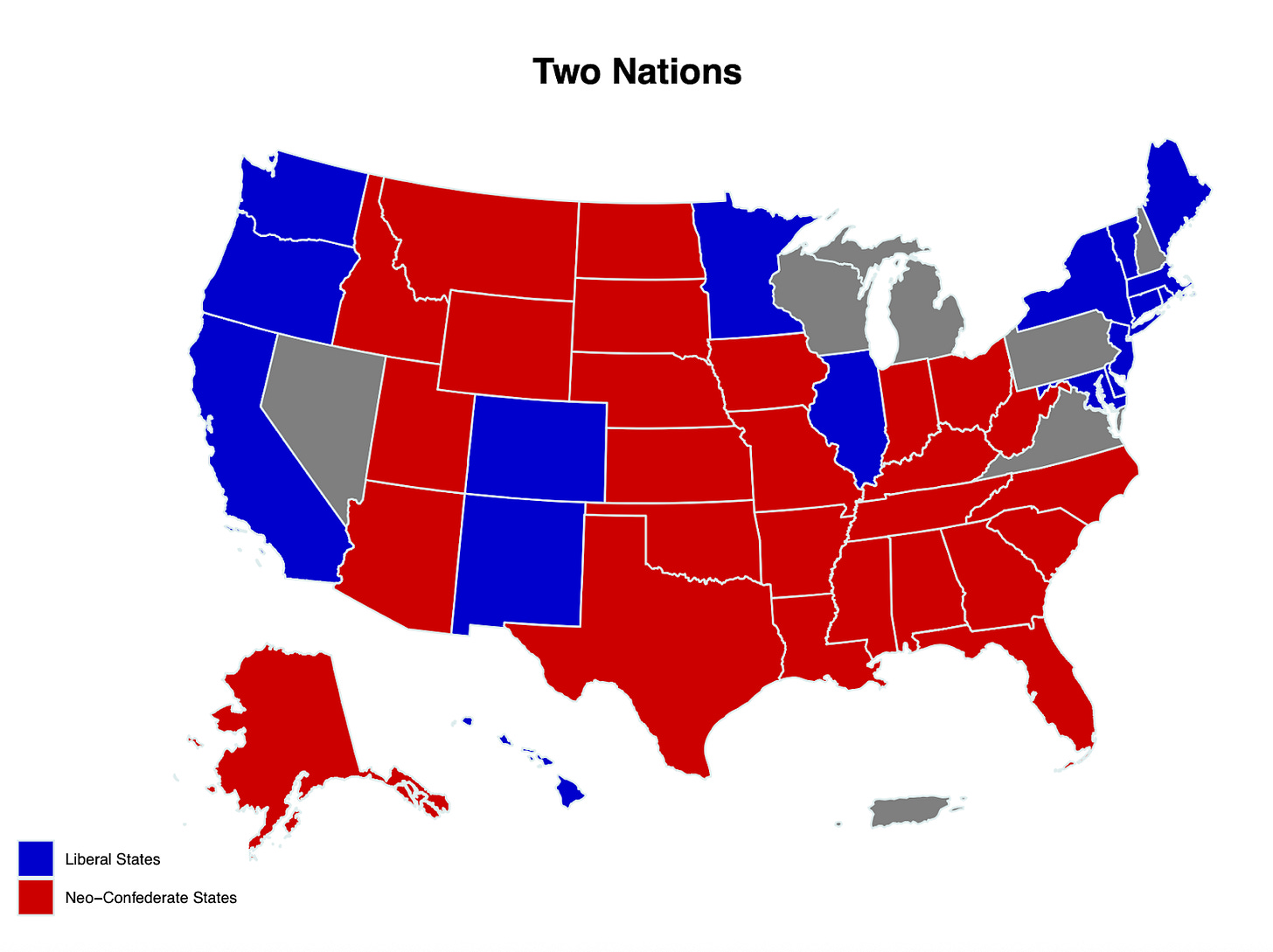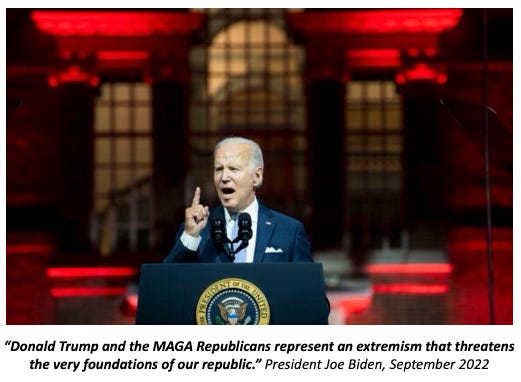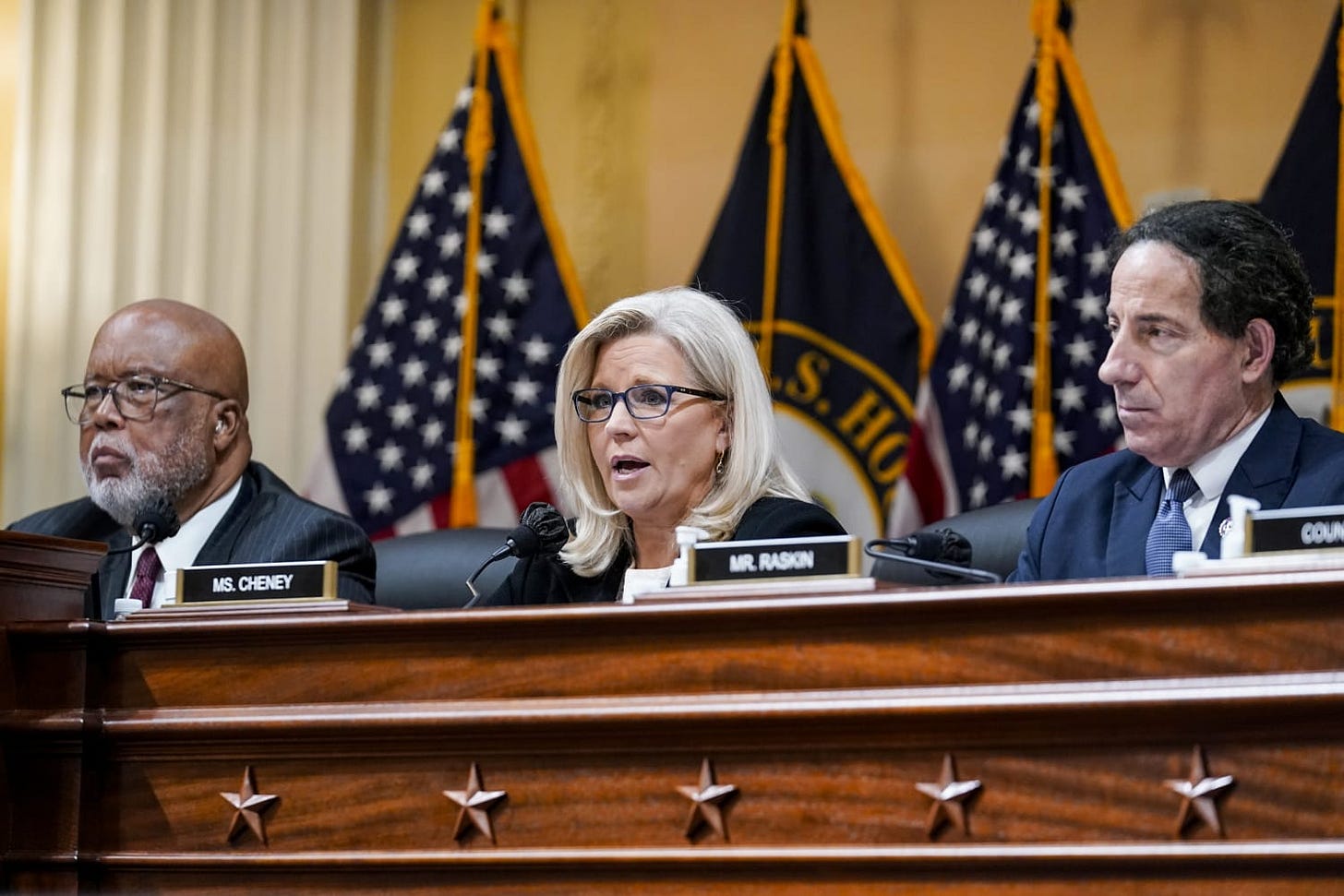Monsters and Their Enablers
A Weekend Reading Reboot
After a few months of not publishing, today’s post will serve as a sort of Weekend Reading reboot. Although no one framework can be comprehensive, I hope today’s post will offer one that begins to equip us for the state of exception we find ourselves in—how we got here and the prerequisites for progress. The propositions introduced here will be developed in greater depth and more nuance in the coming weeks.
Some say my posts run long; others like the depth. To balance that, from now on, in addition to regular footnotes for citations and shorter clarifications, I’ll also use endnotes—marked (Endnote¹)—for deeper dives: extra evidence, side arguments, rebuttals, and clarifications. If a claim feels implausible, check the endnotes for my fuller response.
Monsters …
I began Weekend Reading in March 2017 because the urgent task was to defeat Trump in the midterms and in 2020.1 After that, it didn’t take long to see that thwarting his return to office in 2024 had become the most urgent task. But Trump was never the most important danger to the country. He was only the worst-case consequence of the most important danger to the country: the ascendance of a plutocratic/white Christian nationalist coalition that has captured the Republican Party.2 Together, the plutocrats and the white Christian nationalists form the twin pillars of the Neo-Confederacy—one wielding concentrated wealth, the other leveraging hierarchy and mobilizing faith. Together, they are winning a modern war of Southern aggression.
That revanchist coalition’s success began by capturing the Supreme Court in order to remove the guardrails that had contained them separately for decades or more. The Court enabled them to do, or undo, by judicial fiat what could not be imagined through anything resembling a democratic process. Unshackled by a Supreme Court stocked with justices committed to their agenda, and with the wind of popular backlash to two decades of elite failure at their backs, the two revanchist factions, long thought vanquished, prevailed. They quickly purged RINOS up and down the ballot to gain a lock on the governments in the states in which half of Americans live, and then, through line drawing, primaries, and intimidation, came to control nearly the entirety of the Republican Caucuses in the House and Senate.
Eight months into the Trump 2.0 regime, as that revanchist coalition aggressively consolidates its neo-Confederate governance in Washington, DC, winning elections and lawsuits as well as protesting continues to be necessary, but clearly insufficient, to achieve the America that Langston Hughes conjured as “the land that never has been yet - and yet must be.” As I’ve written, we are already deep into America’s second “Redemption”—a period of ruthless backlash to social progress, enabled by the acquiescence of those who claimed to be the guardians of that progress.
A century ago, in a time with many similarities to our own, Antonio Gramsci recognized that: The old world is dying, and the new world struggles to be born: now is the time of monsters. Then, as now, the shambles left by unchecked capitalism and a generation of failed leadership fueled catastrophic alternatives: Soviet totalitarianism on one side, and on the other the fascist axis of Germany, Italy, Spain, and Japan. But that outcome was not inevitable. In the United States, the New Deal prevailed despite substantial sympathy for fascist movements at home.
Today, that resurgence of unfettered capitalism—compounded by a generation of failed leadership—has unfolded along divergent paths in what I will call the Neo-Confederate States and the Liberal States.3 We casually label them “red” and “blue,” but doing so makes the mistake of attributing the divide to the policy, marketing or branding choices made by each party.
In truth, the divide is not about the choices the parties make but about the fundamental differences in population, economies, and values between what is best understood as two different social systems—or two “nations,” as I’ve also called it. The divide reflects the far deeper struggle between competing regional hegemonies, never fully extinguished in 250 years, rooted in the dominance of distinct entrenched interests and the radically divergent ways of life those interests have produced. The Republican Party operates chiefly as the political agent of the Neo-Confederate States, while the Democratic Party serves as the standard-bearer for the aspirations of the Liberal States; neither party is a free-floating institution, independent of the regional orders that constitute them. (Endnote.4)
… And Their Enablers
But that is only half the story. The other half is about the utter and continuing failures of the political class and civil society here5 in the Liberal States. To be sure, the “resistance” since January 20, 2025—in courts, legislatures, the press, and civil society—has been indispensable in slowing the regime. Yet almost no opposition figure with authority or resources has acknowledged their own complicity—however unwitting—in allowing the regime to rise and thrive, let alone reconsidered their assumptions, let alone substantially revised the strategies that massively failed or turned to those who saw this coming all along. Instead, they persist in acting as though electoral victories alone will suffice to contain the monsters now in charge, while promising to restore the very order that proved the fertile ground for their rise—an order already long dead.
Rhetoric Without Resolve
In 2020, Joe Biden cast his campaign in epic terms: a “battle for the soul of America.” Trump, he warned, was not just a rival politician but an existential threat to the republic. But if democracy truly was at risk, then winning elections could not be the only answer. Guardrails had to be built, and quickly. In the years that followed, Democrats had the chance to build them—and chose not to. When they had unified government, the filibuster became their excuse. When they held only the Senate in 2023–24, they could have still forced debates, pinned Republicans down, and put the House in the position of defending indefensible positions. But they did not.
Here is an overview of how their inaction, coupled with the media’s indifference, enabled Trump’s return to the White House and gave him more room to do more damage once he got there.
Senate Democrats were not willing to carve out the filibuster to protect voting rights, and the Biden Administration didn’t press the point—despite claiming that we were facing the greatest threat to democracy since the Civil War. This threat was driven by more than a decade of Roberts Court decisions that triggered a torrent of voter suppression, gerrymandering, and election subversion laws enacted in the Red States. (Endnote.6)
Similarly, despite the ways in which Trump’s first term exposed how easily presidential powers could be twisted for personal or political ends, Democrats failed to address either those abuses or the myriad of other laws that could be construed to provide the pretext for acting on his assertion that he would be a dictator on day 1. (Endnote.7)
As I’ve written about extensively, the Roberts Court was rewriting the Constitution by fiat, triggering louder and louder calls for “court reform” in the 2020 election. However, as with the jettisoning of filibuster reform, even for essential carve-outs, the Administration smothered the possibility of action by forming a commission on Supreme Court reform, which included representation from the right-wing Federalist Society. It published an obscure, nearly 300-page report that no one read. Even when the Supreme Court increasingly altered the basic meaning of the Constitution to protect Trump, first in Anderson and then in Trump v. US, the Democrats turned to none of the proposed reforms.
If all of that (especially if you read the endnotes) seems like asking too much, remember that in the wake of Watergate, a crime trivial in comparison to rampant lawlessness of Trump 1.0 and his campaign promises for Trump 2.0, Congress moved quickly to erect new guardrails against executive abuse. The War Powers Resolution limited unilateral warmaking; the Federal Election Campaign Act created the FEC and imposed finance rules; the Ethics in Government Act established financial disclosures and independent counsels; FISA brought secret surveillance under judicial review; FOIA was strengthened; and permanent intelligence committees were created alongside the Budget and Impoundment Control Act. Just as striking, top Nixon aides—including Attorney General John Mitchell, Chief of Staff H.R. Haldeman, Domestic Policy Advisor John Ehrlichman, and others—were convicted of perjury, conspiracy, and obstruction, serving prison time. Even White House Counsel John Dean pleaded guilty and testified against his superiors. Nixon himself resigned rather than face impeachment, and only Gerald Ford’s pardon spared him prosecution.
To be sure, Democrats did not sit idle. Trump was impeached twice, and the January 6th Committee produced a damning record of his effort to overturn an election. But apart from the impeachment immediately after January 6th, these initiatives were driven mostly by determined members of Congress and civil society advocates who pressed for accountability against constant headwinds. They faced resistance not just from Republicans but from other Democrats, the mainstream media, “savvy” strategists, and the legal establishment, all of whom insisted that “America wanted to move on.” Those who argued that the fight had to continue were told voters didn’t care about democracy, that the true mandate was bipartisanship, and that pressing too hard on enforcement was not statesmanship but overreach—even though it was the very job they were elected to do.
Incredibly, self-styled democracy groups and much of the media heralded the outcome of the 2022 midterms as a “victory for democracy.” Never mind that Republicans—who had refused to certify the 2020 election, blocked an independent January 6th commission, and defended Trump at every turn— claimed the Speaker’s gavel. Because Democrats’ losses were smaller than expected and Trump-aligned candidates failed in key statewide races, the press declared democracy safe.
As I wrote in February 2024: The 2024 election is not a contest between two politicians, Donald Trump and Joe Biden, but a de facto constitutional referendum. Project 2025 spelled out, in hundreds of pages, how a second Trump administration would use the myriad of laws granting the president emergency power, use the Insurrection Act to deploy the military domestically and other zombie laws like the Comstock Act, purge the civil service under “Schedule F,” and consolidate power beyond remote precedent.
Yet Democratic leaders once again vacillated—warning that Trump was an “existential threat” while simultaneously preaching unity and bipartisanship. Pundits debated (and still debate) whether democracy should even be a campaign issue. Critics were dismissed as suffering from “Trump derangement syndrome.”
The mixed messaging was devastating. Even Democrats who sounded the alarm did not act as though they believed it themselves. And because those alarms were never matched with action, they lost credibility, making Democrats look like cynics willing to say anything without doing anything. Mainstream media reinforced the gap. Instead of making Project 2025 and the dismantling of guardrails a sustained national conversation, they treated the authoritarian blueprint as partisan fodder, covered episodically and flattened into campaign spectacle. Headlines pivoted from democracy’s collapse to horse-race coverage and “healing” narratives. Even Trump’s promises to invoke archaic laws for authoritarian ends were covered as political controversy, not constitutional crisis.
The result was a perverse form of inoculation. Each failed or abandoned attempt at accountability didn’t just fade away; it immunized the public against future alarms, making warnings about Trump sound weaker every time they were raised. Instead of leaving Republicans indelibly tied to Trump’s abuses, Democrats allowed the urgency to fade, normalizing the very threat they had warned against.
After the 2024 election, Biden and Democratic leaders congratulated themselves for restoring the peaceful transfer of power. Biden even welcomed Trump back to the Oval Office. Democrats spoke of unity as if nothing fundamental was at stake. On January 6th, 2025, neither Biden’s nor Jeffries’s statements mentioned Trump’s name, as if the only crimes were those of the rioters on the Capitol grounds.
In a way, Kamala Harris captured the dilemma in her 2024 DNC speech: “In many ways, Donald Trump is an unserious man. But the consequences of putting Donald Trump back in the White House are extremely serious.” That truth should have been obvious from the moment Trump descended the escalator in 2015. Yet across nine years, Democrats, the political class, and liberal institutions never convinced themselves—let alone the public—that the unseriousness of the man did not lessen the seriousness of the danger. And in treating him as unserious, Democrats and the “pillars” of civil society revealed they themselves were not serious.
The Road Ahead
To return to Gramsci: the old order is dead. It is a testament to the power of cognitive dissonance that those who most righteously swear allegiance to that order are never asked—nor do they seem to ask themselves—whether the world in which they have thrived is precisely the world that produced this crisis. If we are to bring a better order into being, we must begin by recognizing that the sensemakers and leaders who steered us here cannot be the ones to chart the way forward. For as long as we cling to their comforts, we will remain trapped in the interregnum where monsters thrive.
On the first anniversary of January 6th, I wrote:
Civil war or other dystopias will become inevitable unless we look beyond the conventional understanding of our predicament and the options available to us. In the American system, the paved roads inevitably lead to dead ends. To begin, we need new maps.
Seeking out these new maps is going to animate my work at Weekend Reading going forward.
Weekend Reading is edited by Emily Crockett, with research assistance by Andrea Evans.
Weekend Reading began as an invite-only, off-the-record email for the most senior campaign practitioners. The Substack was launched in 2022.
The two pillars:
-Laissez-faire capitalists, discredited by the Depression and contained by the New Deal order; and
-White Christian nationalists, wielding institutional power through Evangelical churches, who have led the backlash against social progress through the generations: against Reconstruction; against the “intrusions” of Brown v. Board of Education, the Civil Rights Act, and Voting Rights Act; and against a variety of advances in the modern era, including the election of the first Black president.
Liberal, as I use the term here, refers not to a set of individual attitudes but to the institutional order of post-cold war, secular America—rooted in lightly regulated capitalism, technocratic governance, and civil rights reform, and sustained by the Democratic Party, elite universities, the press, and civil society.
The Neo-Confederate States: Those who seceded (Alabama, Arkansas, Florida, Georgia, Louisiana, Mississippi, North Carolina, South Carolina, Tennessee, Texas, as well as those enacting strong Jim Crow regimes after Reconstruction (Indiana, Kentucky, Missouri, Oklahoma and West Virginia) as well as Iowa and Ohio.
The Liberal States: Those fighting for the Union during the Civil War (California, Connecticut, Delaware, Illinois, Maine, Maryland, Massachusetts, Minnesota, New Jersey, New York, Oregon, Rhode Island and Vermont)
Iowa, Ohio, Michigan, New Hampshire, Pennsylvania, Virginia and Wisconsin are contested.
So, for example, even though Georgians have elected two Democratic senators and favored Biden in 2020, I classify the state as “Neo-Confederate,” as I do Kentucky and North Carolina, because while Democrats can compete in statewide elections, those occasional victories don’t threaten the MAGA Republican regime’s lock on those state legislatures, foreclosing reversals of the already enacted Neo-Confederate agenda in those states, or threaten dominant local Neo-Confederate interests, including white Evangelical churches and extractive industries.
One of the most common objections to my proposition that we should think of America as two nations is that there are plenty of Trump supporters in Blue America and Harris supporters in Red America. Obviously true. But to the point I am making: over the last decade there are zero examples of MAGA Republicans winning significant statewide office in any Blue State, and only a handful of Democrats—Beshear, Cooper, Bel Edwards, Hobbs—winning in Red States. And even they, while better than the alternatives, have been unable to roll back or restrain the MAGA agenda of their legislatures.
A similar rejoinder comes up when I invoke the interests of the “business community” or “plutocrats”: that corporations and billionaires do not agree on everything. Again, true, but beside the point. Across the board they do agree on what matters most—lower taxes, weaker regulation, and the continued evisceration of unions. And they act on that consensus through coalitions like the Koch network, the Federalist Society, and ALEC. Trump is making enormous progress on those fronts now, which is why they are not blocking him. Many individual corporations and executives dislike his tariffs and see them as bad for the economy, but business has always been willing to accept that trade-off—see the 1920s or the 1980s.
None of this is to say that business knows or controls everything. Often they make decisions that backfire. German industrialists, for instance, were confident they could manipulate Hitler—until they couldn’t. That Trump may ultimately damage some or all of their interests is not evidence that they had no role in elevating him to power. Nor is it to say that their success was inevitable - to the contrary, their success was very contingent - both on external events (the timing of Supreme Court vacancies) and, as I argue, liberal institutions continuously ignoring or underestimating the threats.
For clarity, consistent with the two-nation framework I’m laying out, “here” means in the Liberal States and “we” will mean those who share those credal values.
In response to the Roberts Court’s Citizens United, Shelby, Rucho, Brnovich and other election decisions, as well as a torrent of voter suppression and election subversion laws passed in nearly every Red State, House Democrats passed the For the People Act (H.R.1/S.1) and the John R. Lewis Voting Rights Advancement Act. But neither Senate Democrats nor the Biden Administration sought a filibuster carveout, notwithstanding Biden’s “fiery speech in Philadelphia,” where he “warned that the G.O.P. effort was the ‘most significant test of our democracy since the Civil War.’” In any case, the media frowned on it as it would not have been bipartisan (despite the fact that all of the Roberts Court decisions and the Red State laws they would have addressed were adopted along strictly partisan lines), or as the New York Times put it:
The perception that voting laws have existential stakes for democracy or the political viability of the two parties has made bipartisan compromise extremely difficult. The virtue of bipartisanship is often and understandably dismissed as naïve, but voting laws are a rare case where bipartisanship has value of its own. Democracy, after all, depends on the consent of the loser.
Notwithstanding that the loser has made it clear that their losing elections is irrefutable evidence of voter fraud, this was tantamount to surrendering democratic protections to the very party erecting barriers to voting.
In response, House Democrats passed the Protecting Our Democracy Act (PODA)—a sweeping package that would have reined in emergency powers, strengthened subpoena enforcement, insulated the DOJ from political manipulation, and tolled statutes of limitation so presidents could not run out the clock on accountability. The bill died in the Senate. Other proposals never even made it that far: the ARTICLE ONE Act, which would have required congressional approval to extend national emergencies beyond 30 days, had bipartisan support but never reached the floor. The Saving the Civil Service Act, meant to prevent a future “Schedule F” purge of career officials, also stalled. Meanwhile, Democrats declined to act on glaring abuses already in the record. Despite at least ten episodes of obstruction documented in the Mueller Report, they never initiated impeachment hearings on that basis or revisited the DOJ opinion that a sitting president cannot be prosecuted (it’s not a law). Despite repeated defiance of subpoenas, they never revived inherent contempt or empowered courts to fast-track enforcement. Despite Trump’s open profiteering, they never created a statutory mechanism to enforce the Emoluments Clause. Even after the Supreme Court’s Anderson and Trump v. United States decisions bent constitutional meaning to shield Trump personally, Democrats let the rulings stand. And even the Defense Production Act, designed for wartime mobilization but used by Trump to funnel resources toward his border wall, was left untouched. The upshot was a presidency left as dangerous and unchecked in 2024 as it had been in 2016.
Just as troubling, Congress never moved to fix the deeper vulnerabilities that any authoritarian president could exploit. The Alien Enemies Act of 1798, a relic of the hated Alien and Sedition Acts, still authorizes detention or deportation of foreign nationals; Trump’s aides openly cited it as precedent for mass expulsions. The Insurrection Act of 1807 still grants sweeping authority to deploy the military domestically with almost no checks, despite years of warnings from experts. The Patriot Act of 2001 left intact expansive surveillance powers and vague “material support” provisions that could easily be turned inward. The International Emergency Economic Powers Act (IEEPA, 1977) allows presidents to freeze or redirect vast swaths of economic activity; Trump even floated using it to force American companies out of China. Each of these statutes remains unreformed, a loaded weapon waiting for a president unconstrained by law or democratic norms.








This is a very important, impressive, analysis of how we got in this mess, and failed to act to stop the neoconfederate avalanche. One of the best pieces I have read in a very long time.
This is a damning list of the actions we, as believers in the importance of preserving this country as we saw it, failed to take. I’m not sure, but I think that if constituents had cared more or bn more concerned about Trump’s & the Republicans actions in his 1st term, some, if not all, the guardrails mentioned wd have bn enacted, as they were after Nixon. But after Nixon most of the populace was truly shocked & appalled by his actions. It is a credit (not sure that’s the right word), to the right-wing media that 1/2 the population has gradually come to accept the revanchist & extreme behavior of republicans as acceptable & even justified b/c the “elite” intelligentsia did not respect the “uneducated.” Oh, yeah & the threat of transgenders.
I think our suspicions were lulled by the very fact that their chosen figurehead is a joke in himself. With the natural tendency to believe that “it couldn’t happen here” & the fact that trump himself is an uneducated, illiterate jerk, the liberals persuaded themselves that no real or unfixable damage could really happen. Those who did see & tried to warn us suffered the usual fate of Cassandra’s.